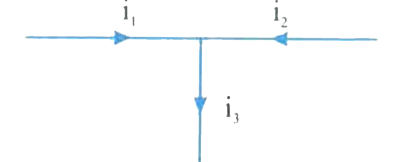Find the resultant amplitude of the following simple harmonic equations :
x1=5sinωt
x2=5sin(ωt+53∘)
x3=−10cosωt
5
10
15
20
The correct Answer is:B
To find the resultant amplitude of the given simple harmonic motions (SHM), we will follow these steps:
Step 1: Write down the equations of the SHMs
The given SHMs are:
1. x1=5sin(ωt)
2. x2=5sin(ωt+53∘)
3. x3=−10cos(ωt)
Step 2: Convert each SHM into phasor representation
- For x1=5sin(ωt), this can be represented as a phasor with an amplitude of 5 at an angle of 0°.
- For x2=5sin(ωt+53∘), this phasor has an amplitude of 5 at an angle of 53°.
- For x3=−10cos(ωt), we convert it to sine form:
x3=−10cos(ωt)=−10sin(π2+ωt)=10sin(ωt+90∘)
This phasor has an amplitude of 10 at an angle of 90°.
Step 3: Resolve the phasors into x and y components
1. For x1:
- x1 components:
- x1x=5cos(0∘)=5
- x1y=5sin(0∘)=0
2. For x2:
- x2 components:
- x2x=5cos(53∘)
- x2y=5sin(53∘)
Using cos(53∘)≈35 and sin(53∘)≈45:
- x2x=5⋅35=3
- x2y=5⋅45=4
3. For x3:
- x3 components:
- x3x=0 (since it is purely vertical)
- x3y=−10 (since it is directed downwards)
Step 4: Sum the components
- Total x-component:
xtotal=x1x+x2x+x3x=5+3+0=8
- Total y-component:
ytotal=x1y+x2y+x3y=0+4−10=−6
Step 5: Calculate the resultant amplitude
The resultant amplitude R can be calculated using the Pythagorean theorem:
R=√(xtotal)2+(ytotal)2=√(8)2+(−6)2=√64+36=√100=10
Final Result
The resultant amplitude of the given simple harmonic motions is 10.
The given SHMs are:
1. x1=5sin(ωt)
2. x2=5sin(ωt+53∘)
3. x3=−10cos(ωt)
- For x1=5sin(ωt), this can be represented as a phasor with an amplitude of 5 at an angle of 0°.
- For x2=5sin(ωt+53∘), this phasor has an amplitude of 5 at an angle of 53°.
- For x3=−10cos(ωt), we convert it to sine form:
x3=−10cos(ωt)=−10sin(π2+ωt)=10sin(ωt+90∘)
This phasor has an amplitude of 10 at an angle of 90°.
1. For x1:
- x1 components:
- x1x=5cos(0∘)=5
- x1y=5sin(0∘)=0
- x2 components:
- x2x=5cos(53∘)
- x2y=5sin(53∘)
- x2x=5⋅35=3
- x2y=5⋅45=4
- x3 components:
- x3x=0 (since it is purely vertical)
- x3y=−10 (since it is directed downwards)
- Total x-component:
xtotal=x1x+x2x+x3x=5+3+0=8
ytotal=x1y+x2y+x3y=0+4−10=−6
The resultant amplitude R can be calculated using the Pythagorean theorem:
R=√(xtotal)2+(ytotal)2=√(8)2+(−6)2=√64+36=√100=10
The resultant amplitude of the given simple harmonic motions is 10.
Topper's Solved these Questions
Similar Questions
Knowledge Check
Find the resultant amplitude of the following simple harmonic equations :
x1=5sinωt
x2=5sin(ωt+53∘)
x3=−10cosωtA5B10C15D20The resultant amplitude due to superposition of three simple harmonic motions x1=3sinωt,
x2=5sin(ωt+37∘) and x3=−15cosωt isA18B10C12DNone of theseThe resultant amplitude due to super position of x1=sinωt,x2=5sin(ωt+37∘) and x3=−15cosωt is :
A17B21C13DNone of these
Find the displacement equation of the simple harmonic motion obtained by combining the motion.
x1=2sinωt, x2=4sin(ωt+π6) and x3=6sin(ωt+π3)
View SolutionFind the amplitude of the harmonic motion obtained by combining the motions
x1=(2.0cm)sinωt
and x2=(2.0cm)sin(ωt+π/3).
View SolutionIf i1=3sinωtand(i2)=4cosωt, then (i3) is

View SolutionThe ratio of amplitudes of following SHM is x1=Asinωtandx2=Asinωt+Acosωt
View SolutionChoose the most appropriate option.
What will be the displacement equation, of the simple harmonic motion obtained by combining the motions?
x1=2sinωt,x2=4sin(ωt+π6)
x3=6sin(ωt+π3)
View Solution

